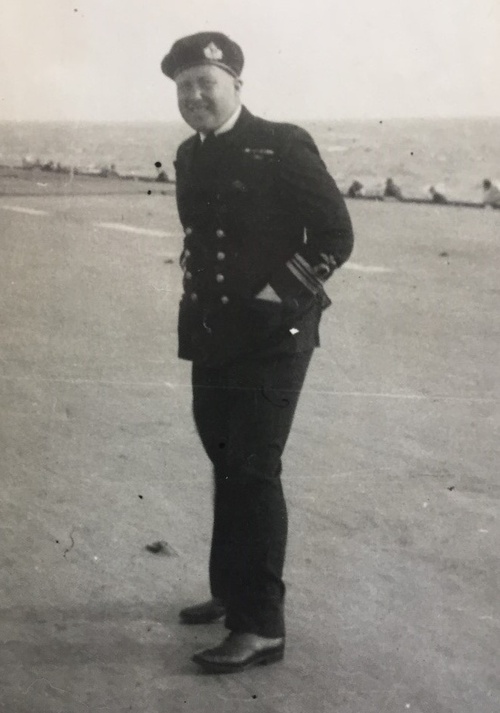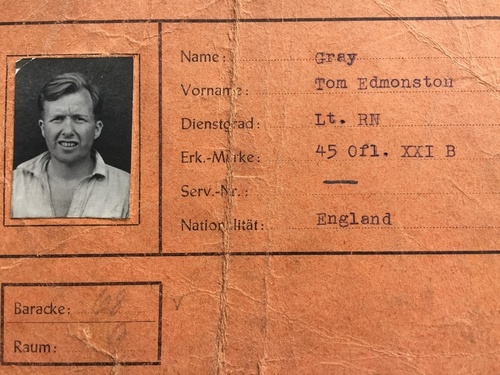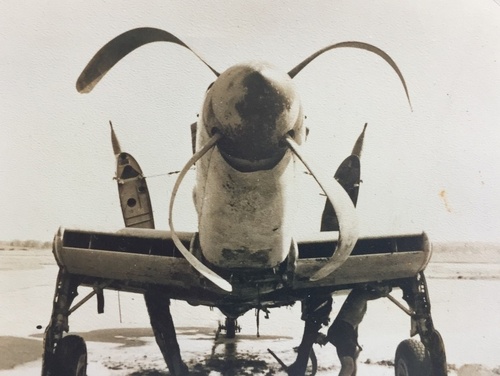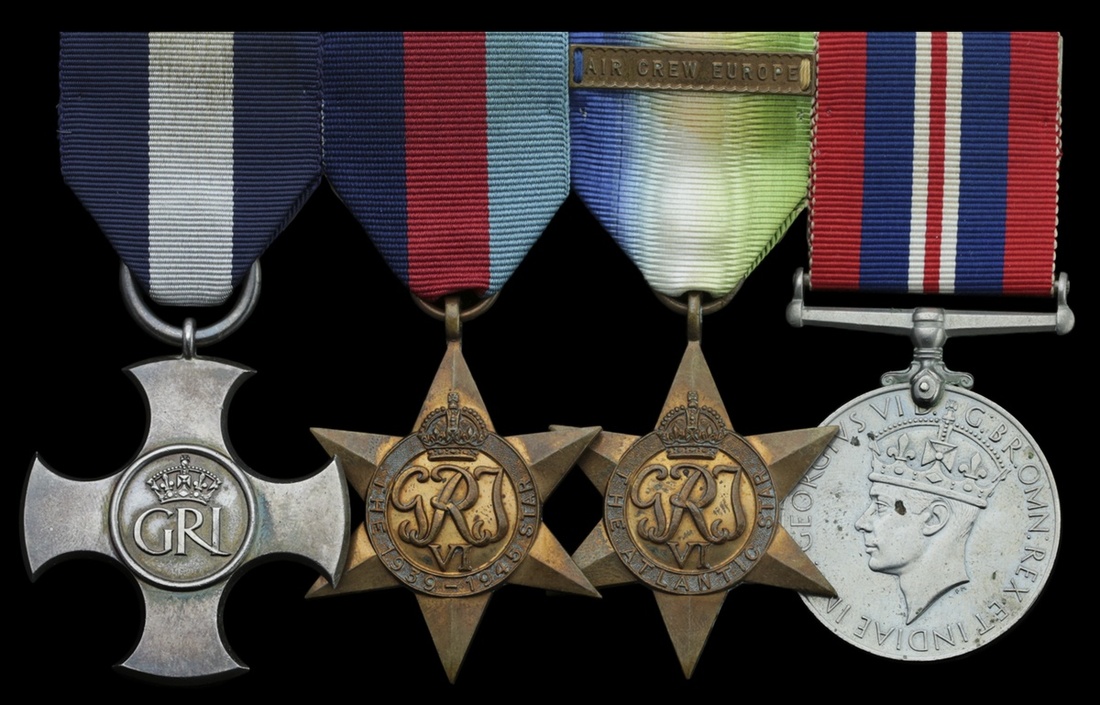Auction: 22003 - Orders, Decorations and Medals
Lot: 432
A rare Norway 1940 operations D.S.C. group of four awarded to Lieutenant-Commander (A.) T. E. Gray, Royal Navy, a gallant Fleet Air Arm pilot who fought a flurry of combats in Ark Royal's Skuas
Having shared in the destruction and damaging of several enemy aircraft, he was himself compelled to make a forced landing in mid-May 1940, when he ran out of fuel after searching for his downed section leader
Just 10 days after receiving D.S.C. at Buckingham Palace in September 1940, he joined the carrier Furious and was shot down in a raid on the oil tanks at Sklaalevik
A cousin of Robert Gray, V.C., D.S.C., R.C.N.V.R., another gallant Fleet Air Arm pilot, he was subsequently incarcerated at Stalag Luft III, scene of the 'Great Escape'
Distinguished Service Cross, G.VI.R., hallmarks for London 1939, officially dated '1940'; 1939-45 Star; Atlantic Star, clasp, Air Crew Europe; War Medal 1939-45, mounted as worn, good very fine (4)
D.S.C. London Gazette 25 June 1940:
'For daring and resource in the conduct of hazardous and successful operations by the Fleet Air Arm on the coast of Norway.'
Tom Edmonstone Gray was born on 3 July 1911 and was originally commissioned into the 4th Battalion, King's Own Scottish Borderers (Territorial Army) in May 1930. Having then been advanced to Lieutenant, he transferred to the Royal Air Force as an acting Pilot Officer in December 1936, joining No. 46 Squadron at Kenley after gaining his 'Wings'.
Then in October 1938, he transferred once again, this time to the Fleet Air Arm as a Sub. Lieutenant (A.). Advanced to Lieutenant (A.) in October 1939, and having gained experience in Skuas, he joined No. 806 (F.A.A.) Squadron at Yarmouth in February 1940.
Norway - hazardous operations
In mid-April 1940, he joined the aircraft carrier H.M.S. Ark Royal, on attachment to 801 and 803 (F.A.A.) Squadrons, and it was in this capacity that he witnessed extensive action off Norway.
He carried out his first sorties on the 24th, 26th and 28th of the same month, including a bombing strike on enemy seaplanes at Trondheim and a lucky deck landing with just one gallon of fuel left. He may also have contributed to the destruction of an He. 111 which crashed into a hillside off Ofotfjord on the 26th.
In the first three weeks of May, up until his transfer to Furious for return passage to the U.K., Gray undoubtedly enjoyed success in a spate of air-to-air combats off Narvik and elsewhere.
On the 7th, flying Skua L2878, with Lieutenant C. L. F. Webb as his Observer, and on the 8th, with Naval Airman 1st Class H. Pickering as his Observer, he appears to have shared in the destruction of an He. 111 over Ofotfjord and in the damaging of a Ju. 88 and He. 111 over Narvik and Harstad.
But it was on the 14th, when piloting Skua L2918, with Leading Airman A. Clayton as his Observer, that he had his busiest day. His combat report takes up the story:
'Bombed 'Furious Lake'. Observed almost direct hit by Leader. Patrolled Narvik area for approximately one hour. Received enemy bombing report and climbed West to 'Resolution' at 17,000 feet. Observed Heinkel 111K bomber above 'Resolution'. Chased this south for approximately 10 minutes.
Abandoned chase and returned to Narvik and found No. 3 in section had become detached. On return received further enemy report from 'Resolution'. Returned West and observed heavy A.A. fire at one bomber. This turned towards Narvik and dropped two bombs on a destroyer, which missed by two lengths. This machine climbed steadily out of range.
Observed almost immediately two two's and one single enemy Heinkels approaching from East at 18,000 feet. We broke formation and did a head on attack at leading two to split the formation, while Leader did an astern attack. We did one astern attack after Leader - port engine appeared to be on fire - who then dived on two Heinkels who had dropped to water level. Leader went very close and fired burst - then swung away - machine appeared to flash as we passed. Fired good burst and observed port engine smoking in one machine.
I then broke off attack and searched for Leader. Found wreckage - consisting of tail unit floating and dinghy - at point Barden. Observed no signs of personnel but proceeded to pick up a destroyer at Ramsundet. Having shown spot to destroyer proceeded to Ramsundet where I forced landed at approximately 1800 hours due to petrol shortage.
Salvaged:
Beacon set
Very pistols
Parachutes and Harness
W./T. coils
Transmitter and receiver
Generator
Lewis gun and pans
Notes:
Enemy coming over at great heights and diving towards targets. Number of machines actually engaged - 4. Lieutenant Lucy's machine appeared to explode at about 50 feet and dived astern of me. I did not see him crash as I was engaging enemy at time.'
Hazardous stuff indeed.
On 25 May, Gray transferred to the carrier Furious and returned to the U.K., where he joined 801 (F.A.A.) Squadron at Detling at the end of the month. He was recommended for the award of the D.S.C.
Norway: Round 2 - P.O.W.
Having been deployed off Dunkirk in May-June 1940, when his squadron suffered heavy loss in combats with Me. 109s, Gray and his fellow aircrew were ordered north to R.N.A.S. Hatston, near Kirkwall in the Orkneys, from whence they carried out long-range strikes on Norwegian targets.
He did however journey south on 3 September 1940 to receive his D.S.C. at a Buckingham Palace investiture.
Just 10 days later, after 801 Squadron had joined the carrier the Furious, he was assigned to an attack on the oil tanks at Sklaalevik, piloting Skua L3030, with Lieutenant J. C. W. Iliffe as his Observer. However, his aircraft was downed near the target area and he was taken P.O.W.
Among other camps, he was incarcerated at Stulag Luft III at Sagan from April 1943 to January 1945 - scene, of course, of the 'Great Escape'. His account of his last days as a P.O.W., as the Allies closed in, is included. He was finally liberated at Luckenwald in May 1945.
Returning to his Fleet Air Arm career, Gray flew Avengers, Fireflies, Hellcats, Seafires and Vampires in the post-war era and was advanced to Lieutenant-Commander (A.) in June 1947. He was placed on the Retired List in October 1956 and died on 17 July 1989.
Sold with an impressive archive of original documentation and photographs, including:
(i)
The recipient's Commission Warrant for the rank of 2nd Lieutenant, 4th Battalion, King's Own Scottish Borderers, dated 30 May 1930.
(ii)
Admiralty appointments to join No. 801 Squadron, H.M.S. Furious, dated 17 October 1938, 802 Squadron, H.M.S. Glorious, dated 9 January 1939 and H.M.S. Peregrine, dated 24 October 1946, together with an H.M.S. Blackcap menu with multiple signatures.
(iii)
A run of ship's 'flimsies', covering the period October 1938 to July 1956, together with several telegrams and Naval Messages, including one of thanks to H.M.S. Encounter for picking up the recipient and his Observer after their forced landing in May 1940.
(iv)
The recipient's 'No. 2' R.A.F. Pilot's Flying Log Book, covering the period January 1940 to March 1956.
(v)
His P.O.W. card for Oflag 45 XXIB, with portrait photograph, and a German identity card "acquired" for 'emergency use. Just in case.'
(vi)
A fine array of career photographs (approx. 100 images), dating from his days in the Territorial Army in the 1930s up until the post-war era, and including good coverage of the wartime era.
(vii)
A display board with the recipient's metalled cap badge, unit badges and uniform ribands.
(viii)
A cassette recording of the recipient's wartime experiences.
Subject to 20% VAT on Buyer’s Premium. For more information please view Terms and Conditions for Buyers.
Sold for
£3,800
Starting price
£1800













